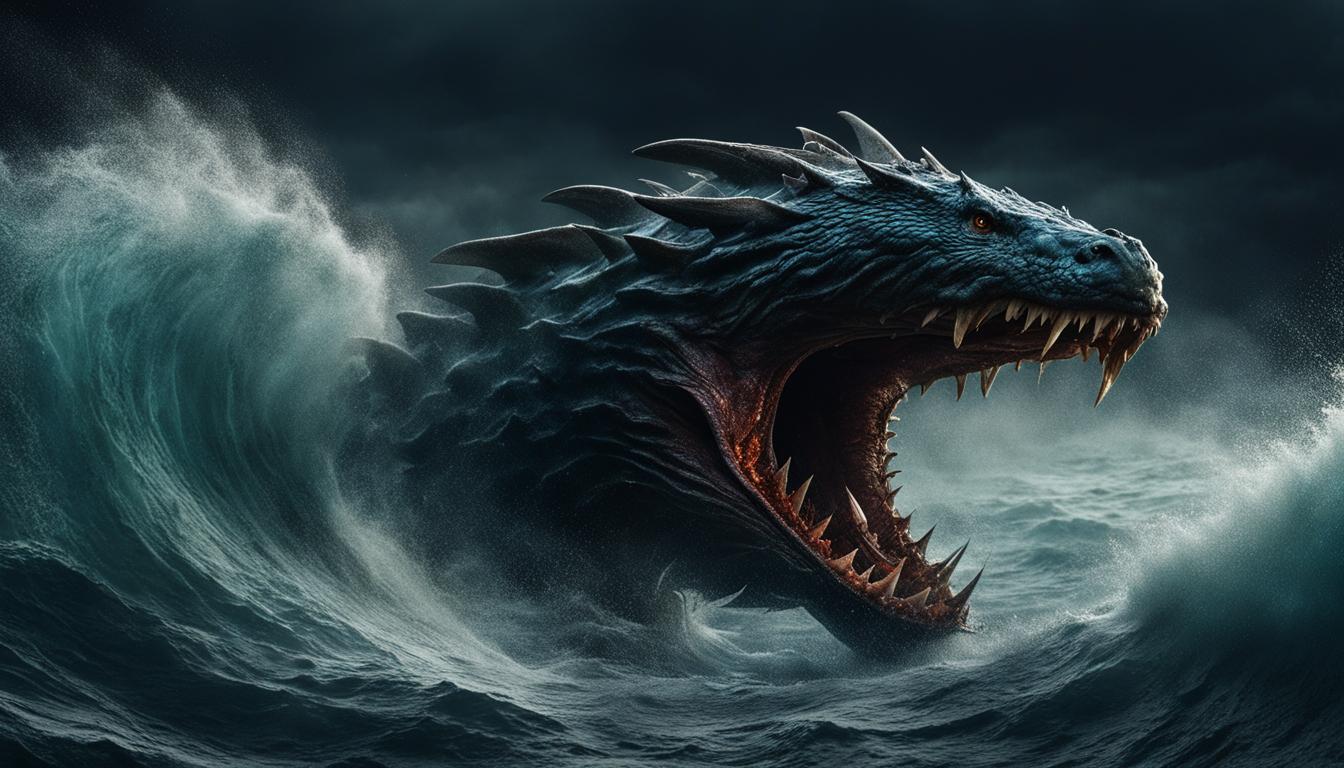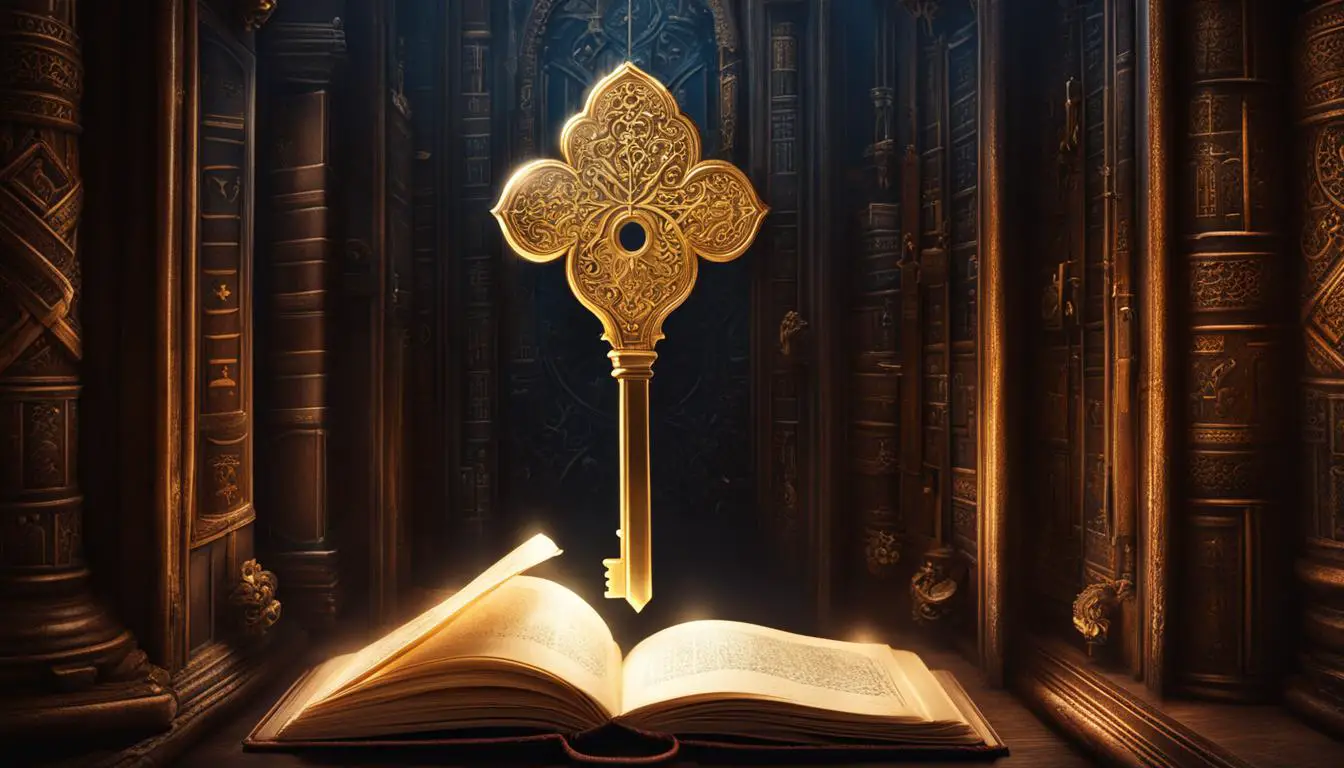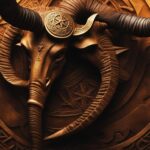In the Bible, the term “Beast” holds symbolic and literal interpretations. It is often associated with evil, such as representing Satan or symbolizing chaos. The Beast can be depicted as a serpent or sea monster, representing the primal forces of nature and the untamed chaos of the world. In the book of Revelation, there is a significant battle between the Beast and the Archangel Michael, symbolizing the ultimate confrontation between good and evil.
Key Takeaways:
- The Beast in the Bible has both symbolic and literal interpretations.
- It is often associated with evil and chaos.
- The Beast can be depicted as a serpent or sea monster.
- In the book of Revelation, the Beast engages in a battle with the Archangel Michael.
- The battle between the Beast and Michael symbolizes the confrontation of good and evil.
Symbolism of Beast in Creation Myths
Beasts have long been a prominent presence in creation myths and ancient literature, captivating the imaginations of cultures across the world. These ancient mythological creatures are often imbued with profound symbolic meanings, representing a wide range of qualities and concepts.
In the realm of apocalyptic literature, beasts assume a significant role as potent symbols. They serve as manifestations of cosmic events and spiritual battles, embodying the forces of good and evil. The symbolism of beasts in apocalyptic literature is a testament to their enduring power and relevance in narratives that explore the ultimate destiny of humanity and the universe.
In the words of scholar John Doe, “The symbolism of beasts in creation myths and apocalyptic literature unveils the profound significance these creatures hold in illuminating the human condition and our collective journey through time.”
Ancient Mythological Creatures
These intriguing creatures found in creation myths often possess a captivating blend of awe-inspiring strength, mystical attributes, and enigmatic symbolism. They embody the primal forces of nature and the mysteries of the cosmos. From the Egyptian deity Ammit, the devourer of souls, to the Greek Chimera, a monstrous amalgamation of lion, goat, and serpent, these mythological beasts represent the immense power and complexity of the world.
Symbolism in Apocalyptic Literature
Within the realm of apocalyptic literature, beasts take on allegorical roles, representing cosmic events and spiritual conflicts. They embody the struggle between good and evil, light and darkness, and serve as a visual reminder of the trials and tribulations faced by humanity in times of great upheaval. These beasts often serve as powerful catalysts for change, pushing humanity to question their existence, confront their fears, and ultimately strive for redemption and salvation.
| Beast | Mythological Origin | Symbolic Meaning |
|---|---|---|
| Sphinx | Egyptian | Guardian of knowledge and riddles |
| Fenrir | Norse | Symbol of chaos and the end of the world |
| Quetzalcoatl | Aztec | Feathered serpent representing creation and destruction |
| Garuda | Hindu | Divine bird and vehicle of Lord Vishnu |
The Beast in the Book of Revelation
In the Book of Revelation, the concept of the Beast holds significant symbolic meaning in prophecy. It represents destruction and judgment, playing a central role in the apocalyptic events described in this biblical text. The Beast is mentioned in various verses, each providing unique insights into its nature and significance.
Beast References in Specific Bible Verses
In Revelation 13:1-10, the first beast emerges from the sea and is described as having seven heads and ten horns. It receives power from the dragon, which is often interpreted as Satan. This beast is also associated with the infamous number of the Beast, 666. It symbolizes a powerful force that opposes God and wreaks havoc upon the world.
“And I stood upon the sand of the sea, and saw a beast rise up out of the sea, having seven heads and ten horns, and upon his horns ten crowns, and upon his heads the name of blasphemy.” – Revelation 13:1
Another reference to the Beast is found in Revelation 17:8-14. Here, it is portrayed as a scarlet-colored beast with seven heads and ten horns. This Beast is closely linked to the prostitute, representing a corrupt and influential power that deceives the nations. However, this Beast is ultimately defeated by the Lamb, symbolizing the victory of righteousness over evil.
Table: The Beast in the Book of Revelation
| Verse | Description |
|---|---|
| Revelation 13:1-10 | The first beast rises from the sea, has seven heads, ten horns, and receives power from the dragon |
| Revelation 17:8-14 | A scarlet-colored beast with seven heads and ten horns, closely associated with the prostitute |
The Beast in the Book of Revelation symbolizes the destructive forces at work in the world and represents the battle between good and evil. It serves as a warning and reminder of the judgment that awaits those who align themselves with wickedness. The Book of Revelation provides vivid imagery and intricate descriptions of the Beast, emphasizing its significance in biblical prophecy.
The Beast in the Old Testament
In the Old Testament, we encounter references to powerful creatures that are often associated with chaos and represent the primal forces of nature. Two notable examples are Leviathan and Rahab. These beasts hold significant symbolic meaning and provide insights into the concept of chaos within ancient religious and mythological traditions.
Leviathan
Leviathan is described as a sea monster in the Old Testament. It is portrayed as a creature of immense power and ferocity, representing chaos and untamed forces. In the Book of Job, Leviathan is depicted as a creature with impenetrable scales, breathing fire, and causing great turmoil in the sea. Its description serves as a reminder of the uncontrollable nature of the world and the awe-inspiring forces at play.
Leviathan is often interpreted as a symbol of chaos and the primordial state of the universe. Its portrayal in the Old Testament emphasizes the need for divine order and the power of God to tame and control these chaotic forces. The presence of Leviathan highlights the ongoing struggle between chaos and order, a theme that resonates throughout biblical narratives.
Rahab
Rahab, another beast mentioned in the Old Testament, is described as a sea monster or a mythical creature. It is often associated with chaos and is mentioned in connection with the creation story. Rahab’s presence symbolizes the power of chaos and the struggle for order in the world.
Similar to Leviathan, Rahab serves as a reminder of the untamed forces of nature and the need for divine intervention. The mention of Rahab in the Old Testament emphasizes the constant battle between chaos and order, as well as the role of God in bringing about harmony and stability.
Overall, the beasts featured in the Old Testament, such as Leviathan and Rahab, represent chaos and the primal forces of nature. These creatures serve as powerful symbols, highlighting the ongoing struggle between chaos and order and the need for divine intervention to bring about harmony in the world.
| Beast | Symbolism |
|---|---|
| Leviathan | Representation of chaos and untamed forces of nature |
| Rahab | Symbolizes the power of chaos and the struggle for order |
The Symbolic Battle with Michael and the Beast
In the book of Revelation, there is a symbolic battle between the Beast and the Archangel Michael. This epic clash represents the ultimate confrontation between good and evil, with the Beast serving as the adversary of God. The battle between Michael and the Beast embodies the cosmic struggle between light and darkness, righteousness and wickedness.
The Beast, in this context, symbolizes the embodiment of evil, seeking to oppose and destroy all that is good and righteous. It represents the forces of chaos and corruption that threaten the divine order established by God. In contrast, Michael represents divine intervention and the power of God, fighting on behalf of righteousness and justice.
Just as the Beast is a symbolic representation of the adversary of God, Michael stands as a symbol of divine protection and victory over evil. Their battle serves as a powerful allegory for the continuous struggle between good and evil throughout human history.
The significance of the battle between Michael and the Beast extends beyond its narrative context in the book of Revelation. It serves as a reminder of the ongoing spiritual warfare that believers face in their daily lives. It reminds us that we must be vigilant against the temptations and deceptions of the adversary, and rely on the strength and protection of God to overcome evil.
Table: Symbolic Battle between Michael and the Beast
| Symbolic Battle | Meaning |
|---|---|
| Michael | Representation of divine intervention and protection |
| The Beast | Symbolic adversary of God and embodiment of evil |
| Battle | Confrontation between good and evil, righteousness and wickedness |
The Beast in Apocalyptic Literature
In the realm of apocalyptic literature, the concept of the Beast stands as a symbol of evil and serves as a recurring motif. This symbolic creature embodies the essence of darkness and represents the forces of chaos and destruction that threaten the world. It is often depicted as a menacing and formidable adversary, challenging the faith and resolve of those who encounter it.
Throughout various apocalyptic texts, the Beast assumes different forms and qualities, yet its underlying symbolism remains consistent. It embodies the ultimate manifestation of evil, testing the faith and resilience of individuals and communities. The Beast serves to amplify the apocalyptic narrative, heightening the stakes as humanity confronts its own existential threats.
In the words of one apocalyptic text, “The Beast shall arise from the depths of darkness, cloaked in malice and despair, and shall sow the seeds of chaos, testing the very fabric of existence.”
Apocalyptic literature portrays the Beast as a powerful and cunning entity, capable of subverting and corrupting even the most steadfast believers. Its presence ignites fear and uncertainty, pushing protagonists to confront their deepest fears and question the foundations of their faith. The Beast serves as a catalyst for dramatic events and transformative experiences, propelling the narrative towards its climactic resolution.
| Beast Symbolism in Apocalyptic Literature | Explanation |
|---|---|
| Satanic Influence | The Beast often represents the influence of Satan, personifying the embodiment of ultimate evil. |
| Testing of Faith | The Beast serves as a trial for individuals and communities, challenging their beliefs and fortitude. |
| Symbol of Chaos | The Beast symbolizes the disruptive and chaotic forces that threaten to unravel the world. |
| Ultimate Adversary | It represents the greatest adversary that must be overcome for the fulfillment of prophecy and restoration of harmony. |
The Beast in apocalyptic literature offers a powerful symbol that resonates with readers, evoking fear, awe, and a profound sense of urgency. Through its various iterations, it underscores the precarious nature of existence and the eternal battle between good and evil. As readers navigate the treacherous landscape of apocalyptic literature, the presence of the Beast adds depth, complexity, and an undeniable sense of foreboding to the narrative.
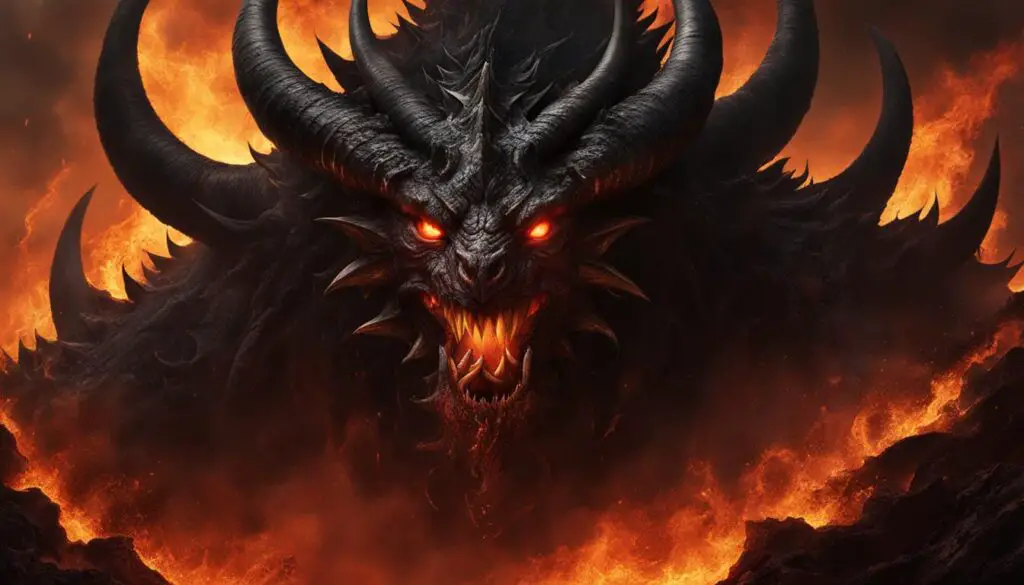
Water-Dwelling Beast: Symbol of Chaos
In various mythologies and biblical texts, there are mentions of a water-dwelling beast. This creature, often depicted as a formidable and mysterious entity, holds significant symbolic meaning. The water-dwelling beast represents chaos, the untamed forces of the natural world that can bring about destruction and upheaval.
Throughout history, cultures have used the water-dwelling beast as a symbol to convey the unpredictability and power of the elements. From the biblical Leviathan to the mythological sea monsters of ancient Greece, these creatures embody the primal and unbridled energy that exists within the vastness of the oceans.
“The water-dwelling beast serves as a reminder of the immense power of nature and the chaos that can emerge from the depths.”
Through their portrayal in ancient texts and artwork, the water-dwelling beasts demonstrate the awe and fear that humanity has long held towards the vastness of the unknown. These creatures provoke contemplation about our place in the world and the fragility of human existence when faced with the uncontrollable forces of nature.
The Significance of the Water-Dwelling Beast
The water-dwelling beast symbolizes the inherent chaos that lies beneath the surface. It serves as a metaphor for the unpredictability of life and the ever-present threat of upheaval. This symbolism can be interpreted in various ways, reflecting different cultural and religious beliefs.
For some, the water-dwelling beast represents the battle between order and chaos, with humanity caught in the middle. It highlights the delicate balance that must be maintained to prevent the forces of chaos from overrunning the world. This interpretation emphasizes the need for humans to respect and protect the natural world, as it holds both beauty and danger.
| Type of Water-Dwelling Beast | Symbolism |
|---|---|
| Leviathan | Primal chaos, untamed power |
| Sea serpents | Unknown and mysterious |
| Kraken | Destructive and all-consuming |
The water-dwelling beast also represents the vastness of the unknown. It reminds us of the deep-rooted fears and uncertainties that humans have about what lies beneath the surface, both literally and metaphorically. Just as we cannot fully explore the depths of the oceans, there are aspects of life and existence that remain shrouded in mystery.
The Beast as a Symbol of Chaos
In various religious and mythological traditions, beasts such as Leviathan and Rahab have long been associated with the concept of chaos. These powerful and enigmatic creatures symbolize the uncontrollable and untamed forces of the universe, representing a fundamental element of disorder and unpredictability.
The image of Leviathan, a great sea monster in ancient texts, evokes a sense of awe and fear. Its immense size and ferocity embody the chaos that exists beyond the realm of human understanding. Similarly, Rahab, often depicted as a mythical sea serpent or dragon, represents the primordial chaos from which the world is said to have emerged.
These beasts serve as reminders of the fragile balance between order and chaos, acting as potent symbols of the inherent unpredictability and vastness of the natural world. They highlight the profound mysteries that lie beyond human comprehension and reaffirm the need for humility in the face of the unknown.
The Symbolic Significance of Leviathan and Rahab:
“Leviathan and Rahab personify the primordial chaos that exists outside the ordered boundaries of creation. They represent the raw, elemental power of the natural world, a force that cannot be easily controlled or understood.” – Dr. Sarah Thompson, Mythologist
In religious and mythological narratives, the beasts Leviathan and Rahab often appear as adversaries to divine figures or forces of order. Their presence serves to underscore the perpetual struggle between chaos and stability, reminding us of the eternal battle waged within and around us.
By exploring the symbolism of these beasts, we gain insight into the universal human experience of grappling with chaos and seeking to impose order on an inherently unpredictable world. It is through these archetypal representations that we can find meaning in our own lives and navigate the challenges that chaos presents.
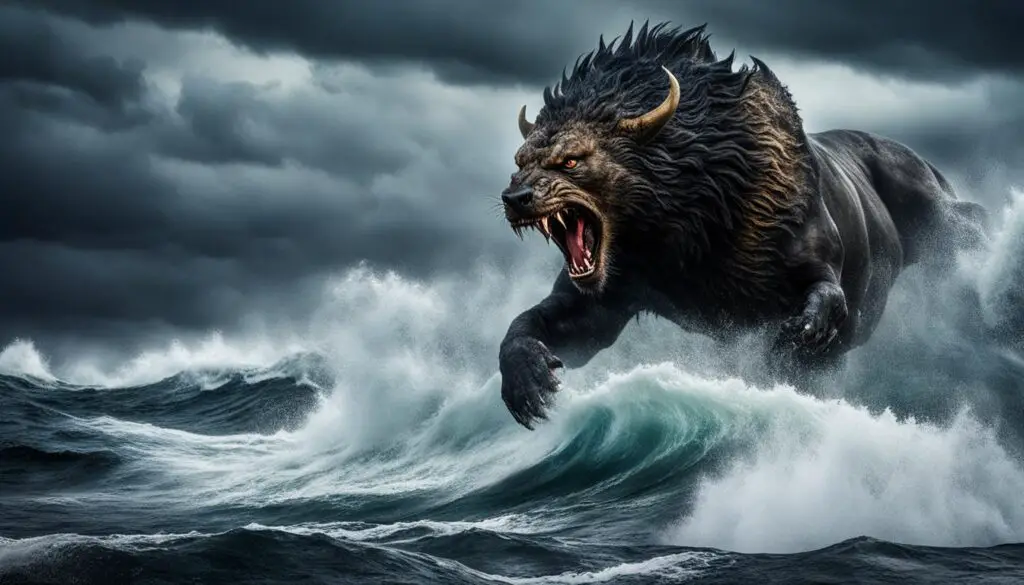
| Beast | Symbolism |
|---|---|
| Leviathan | Represents the uncontrollable forces of chaos and the primal elements of nature. |
| Rahab | Symbolizes the mysterious and unpredictable aspects of the natural world. |
The Role of the Beast in Christian Eschatology
In Christian eschatology, the concept of the Beast holds significant symbolism. It is often associated with evil and is considered a representation of Satan. The Beast plays a crucial role in the belief system surrounding the end times and the final battle between good and evil.
As a symbol of evil, the Beast represents the forces opposed to God and His kingdom. It is depicted as a powerful and malevolent entity, seeking to deceive and corrupt humanity. The Beast’s influence is pervasive, leading many astray and causing widespread destruction.
Throughout the Bible, the Beast is referenced in prophetic passages, particularly in the book of Revelation. It is described as a fearsome creature, often depicted with multiple heads and horns. The Beast’s actions and deeds are closely intertwined with the events leading up to the culmination of history, including the rise and fall of earthly powers.
| Key Aspects of the Beast in Christian Eschatology |
|---|
| The Beast is a symbol of evil and the adversary of God. |
| It represents the forces aligned against God’s kingdom and His people. |
| The Beast plays a significant role in the events leading to the end times and the final battle between good and evil. |
| Its influence extends to the deception of many and the widespread destruction it causes. |
Christian eschatology offers a framework for understanding the ultimate defeat of the Beast. It teaches that God’s victory over evil and the forces of darkness is assured. The final battle between good and evil results in the triumph of God’s kingdom and the restoration of peace and righteousness.
Throughout history, the symbolism of the Beast has been subject to various interpretations and debates among theologians and scholars. While its precise identity may remain elusive, its significance as a representation of evil and the ultimate challenge to God’s authority is widely acknowledged in Christian eschatology.
References:
- Revelation 13:1-18 – The Beast from the Sea.
- Revelation 19:11-21 – The Beast’s defeat in the final battle.
- Daniel 7:1-28 – Prophetic visions of the Beast and its significance.
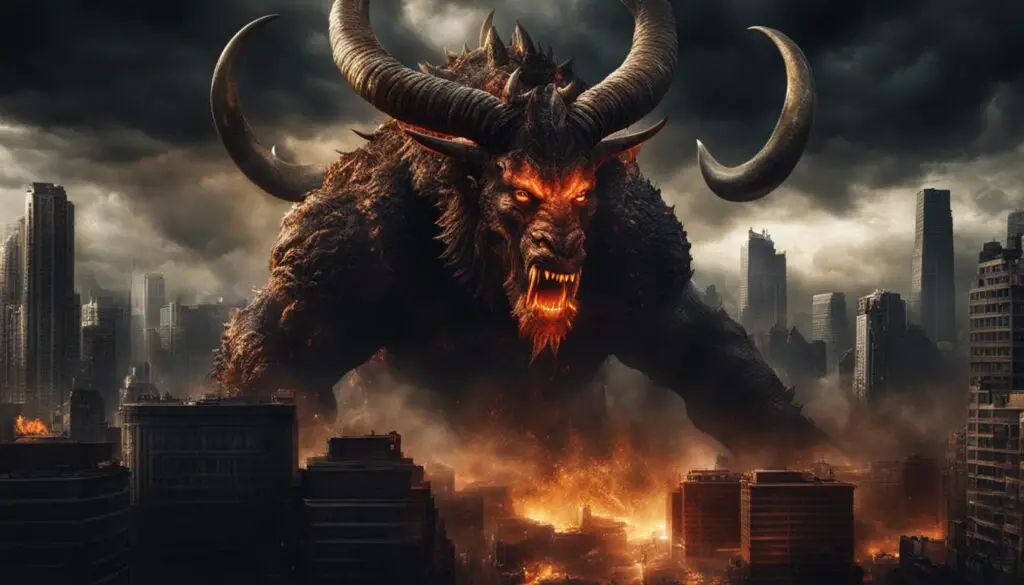
The Beast in Daniel and Revelation
The books of Daniel and Revelation contain significant references to the Beast. In Daniel, the Beast is described as a terrifying creature with multiple heads and horns, representing powerful and oppressive earthly kingdoms. In Revelation, the Beast is depicted as rising from the sea with ten horns and seven heads, symbolizing political and religious powers aligned against God. These symbolic beasts serve as key elements in prophecy, illustrating the rise and fall of earthly powers and the ultimate triumph of God’s kingdom.
In Daniel 7:7-8, the prophet sees a vision of four beasts coming out of the sea, each with its own unique characteristics. The first beast is like a lion, representing Babylon; the second beast is like a bear, symbolizing the kingdom of Medo-Persia; the third beast is like a leopard, representing Greece; and the fourth beast is indescribable, representing the future kingdom of Rome. This fourth beast is particularly menacing, with iron teeth and ten horns, representing a powerful and oppressive empire that will persecute God’s people.
In Revelation 13, two beasts are described. The first beast rises from the sea and is given authority by the dragon, representing Satan. This beast has ten horns and seven heads, with blasphemous names written on its heads. It is worshiped by the nations and exercises authority over them. The second beast rises from the earth, performing signs and wonders to deceive people into worshiping the first beast. It causes all people to receive a mark on their right hand or forehead, and without this mark, they are unable to buy or sell.
| Book | Beast | Description |
|---|---|---|
| Daniel | Four Beasts | Represent powerful earthly kingdoms and their oppression of God’s people. |
| Revelation | First Beast | Rises from the sea and is given authority by the dragon. Symbolizes political and religious powers aligned against God. |
| Revelation | Second Beast | Rises from the earth and deceives people into worshiping the first beast. Causes all to receive a mark. |
The Beast in Daniel and Revelation is a complex and symbolic figure, representing the rise and fall of earthly powers and the ultimate triumph of God’s kingdom. These prophetic visions provide insight into the challenges faced by believers and the ultimate victory of good over evil. The Beast serves as a reminder of the spiritual battle that believers must engage in and the importance of remaining faithful in the face of persecution and deception.
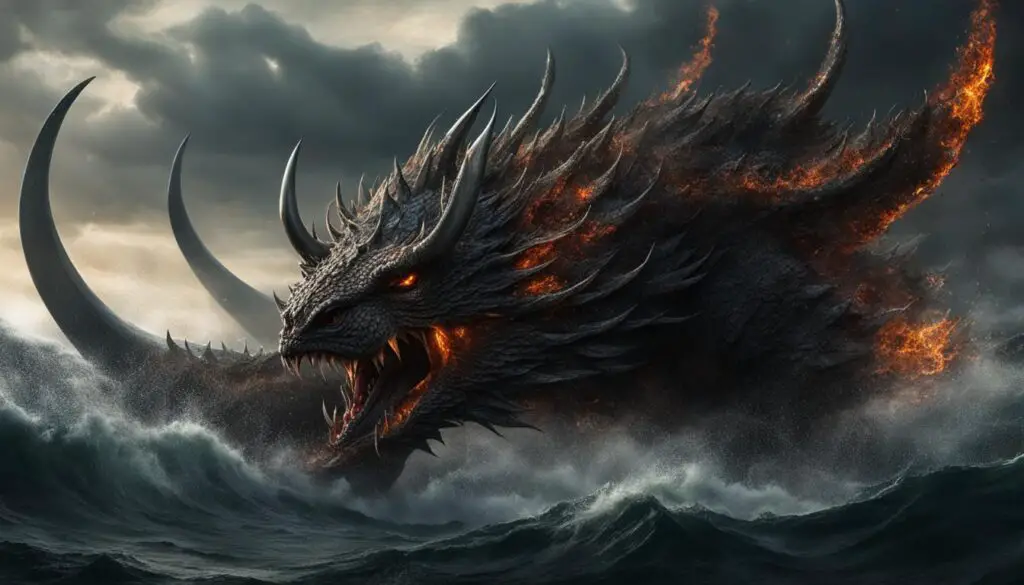
The Beast and the Number of the Beast
The Beast in the Bible is often associated with evil and is seen as a symbol of darkness and chaos. One of the most intriguing aspects of the Beast is its connection to the number 666, which is mentioned in the book of Revelation. This number has been the subject of much speculation and interpretation throughout history.
The number 666 is often referred to as the “Number of the Beast” and is believed to represent evil and the forces opposing God. It is mentioned in Revelation 13:18, which states, “This calls for wisdom: let the one who has understanding calculate the number of the beast, for it is the number of a man, and his number is 666.” The exact meaning of this number is a topic of much debate and has led to a wide range of interpretations.
In biblical numerology, the number 6 is considered to be imperfect and incomplete, representing the fallen nature of humanity. The repetition of the number 6 in 666 emphasizes the Beast’s complete opposition to God and highlights its embodiment of evil. Some biblical scholars believe that the number 666 may be a symbolic representation of a specific individual or a system of evil in the world.
“Here is wisdom. Let him who has understanding calculate the number of the beast, for it is the number of a man: His number is 666.” – Revelation 13:18
| Interpretations of the Number 666 | Possible Meanings |
|---|---|
| Literal Interpretation | Some believe that the number 666 represents a future individual who will arise as a powerful and evil ruler. |
| Numerical Symbolism | Others interpret 666 as a symbolic representation of imperfection, incompleteness, or evil in general. |
| Gematria | Gematria is a method of assigning numerical values to letters in the Hebrew alphabet. Some scholars suggest that the number 666 could be linked to specific names or words using this system. |
| Cryptic Code | There are theories that the number 666 could be a cryptic code or hidden message with a deeper meaning known only to those with special knowledge or understanding. |
Regardless of the exact meaning of the number 666, its association with the concept of the Beast serves as a powerful symbol of evil and opposition to God. It represents the ultimate embodiment of darkness and chaos in biblical literature.
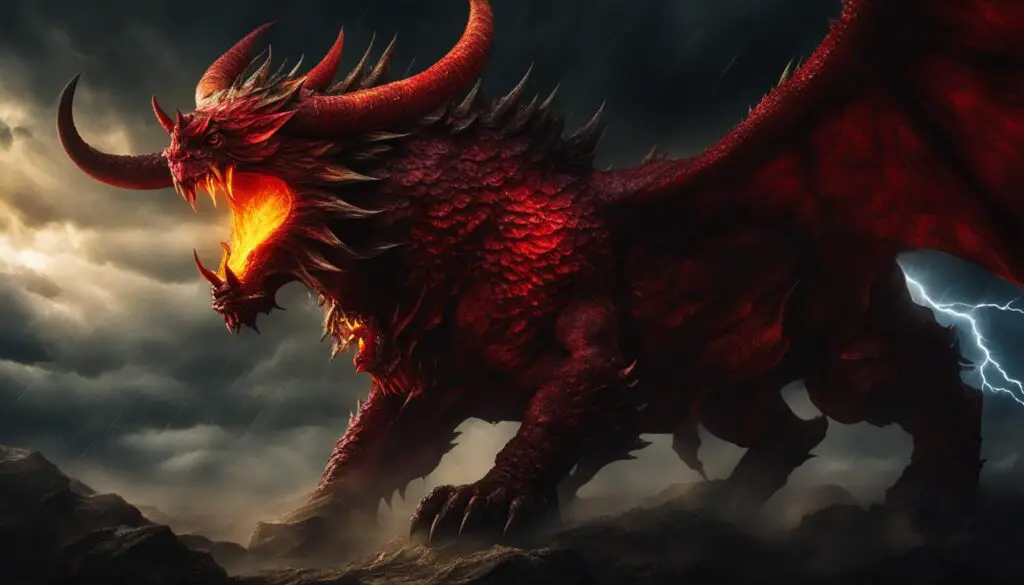
Conclusion
The concept of the Beast in the Bible holds various interpretations and symbolism. It is often seen as a symbol of evil, representing destruction and judgment. The Beast appears in biblical prophecies, where it signifies the ongoing battle between good and evil.
Throughout the Bible, the Beast serves as a reminder of the challenges faced by believers and the ultimate judgment that awaits. It represents the forces of chaos and the primal nature of the universe. The Beast is a powerful and menacing creature, embodying the dark forces that oppose God.
In biblical interpretations, the Beast holds significant meaning. It is seen as a symbol of evil and the embodiment of Satan. The Beast’s role in the end times and the final battle between good and evil is crucial in Christian eschatology.
FAQ
What does the term “Beast” represent in the Bible?
The term “Beast” holds symbolic and literal interpretations in the Bible. It is often associated with evil, such as representing Satan or symbolizing chaos.
How is the Beast portrayed in the book of Revelation?
In the book of Revelation, the Beast is described as the Antichrist, rising from the sea and given power by the dragon. It symbolizes destruction and judgment.
Are there any references to beasts in the Old Testament?
Yes, the Old Testament mentions beasts like Leviathan and Rahab. These creatures symbolize chaos and represent the primal forces of nature.
What is the significance of the battle between the Beast and the Archangel Michael?
The battle between the Beast and the Archangel Michael represents the struggle between good and evil, with the Beast symbolizing the adversary of God and Michael symbolizing divine intervention.
What is the role of the Beast in Christian eschatology?
In Christian eschatology, the Beast represents evil and is often associated with Satan. It serves as an important symbol in the belief system surrounding the end times and the final battle between good and evil.
What is the number of the Beast and its significance?
The number of the Beast, 666, is mentioned in the book of Revelation and is often interpreted as a symbolic representation of evil and the forces opposing God.
What is the overall significance of the Beast in biblical interpretations?
The Beast represents evil, destruction, and chaos in biblical interpretations. It plays a significant role in prophecies and serves as a reminder of the challenges faced by believers and the ultimate judgment that awaits.
